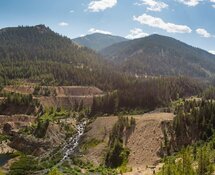 In Jorge Ganoza's opinion, "Argentina is not a mining country; it's not a mining jurisdiction. At federal, state and local levels and municipalities, the governments have little understanding of the industry, so there are bigger risks. If you take bigger risks, you need bigger rewards." Noting that "the cost structure in Argentina is much higher than in Peru," Ganoza says that Fortuna Silver Mines Inc. (FSM:NYSE; FVI:TSX; FVI:BVL; F4S:FSE) would "really need a compelling reason to go to Argentina."
In Jorge Ganoza's opinion, "Argentina is not a mining country; it's not a mining jurisdiction. At federal, state and local levels and municipalities, the governments have little understanding of the industry, so there are bigger risks. If you take bigger risks, you need bigger rewards." Noting that "the cost structure in Argentina is much higher than in Peru," Ganoza says that Fortuna Silver Mines Inc. (FSM:NYSE; FVI:TSX; FVI:BVL; F4S:FSE) would "really need a compelling reason to go to Argentina."Argentina, which has hamstrung Pan American Silver Corp. (PAA:TSX; PAAS:NASDAQ) in its efforts to capitalize on the Navidad property it acquired from Aquiline Resources in 2010, isn't alone among Latin American countries exposing miners to jurisdictional risk. How about Peru?
Last June, the Peruvian government pulled the rug out from under Bear Creek Mining Corp. (BCM:TSX.V), canceling the concession it had been granted for its Santa Ana operation. The Santa Ana mine was slated to produce about 47 million ounces (Moz) silver over an 11-year mine life starting this year. Bear Creek has two other projects in Peru. Corani, a silver-lead-zinc deposit that's nine times larger than Santa Ana but located in a jurisdiction where mining is less contentious, is expected to produce more than 13 Moz silver annually starting in 2014 for the first five years of a 20-year mine life. Bear Creek's flagship project, Corani, represents 80% of the company's value on a pure silver basis. Corani is proceeding toward permitting and construction.
According to Ganoza, a fourth-generation miner from a Peruvian family that has owned and operated several underground gold, silver, and base metal mines, "Peru has been, is and will continue to be a mining jurisdiction. But that is a generalization," he admits. "Parts of Peru are very friendly and amenable to new mine developments. Others aren't, and Santa Ana is in one such location. Bear Creek knew early on that it would face challenges and took a measured risk. We know what happened. I think the government is committed to a resolution of that problem—that is what it has been communicating consistently—but it will take time."
Fortuna has been operating its Caylloma mine profitably in Peru since 2007, Ganoza says, having purchased it and related concessions in 2005. After a significant upgrading and modernization of the ore processing plant, the company returned the mine to production and the facilities are operating at a rate of more than 1,000 tons per day (tpd).
Commercial operations at Fortuna's larger San Jose mine, located in Oaxaca, Mexico, achieved commercial production in September 2011 at a rate of 1,000 tpd. The mine produced 491,000 ounces (491 Koz) silver and 4.6 Koz gold in 2011; for 2012, those figures are expected grow to 1.7 Moz silver and 15 Koz gold. When planned mine expansion and processing plant capacity to 1,500 tpd are complete, annual production is estimated at approximately 3.2 Moz silver and 25 Koz gold. By 2014, Fortuna expects consolidated production to reach 6 Moz silver equivalent per year plus base metal credits.
Did jurisdictional risk in Peru or a desire for asset diversification lead Fortuna to the San Jose operation? "Going to Mexico was not driven by asset diversification or jurisdictional risk at all," Ganoza says. "Mexico and Peru are established, good bases of operation for us. We went to Mexico not to diversify our Peruvian risk but rather because we thought there were good opportunities in Mexico and we had to be there if we wanted to be a world leader in silver production. So we have two anchor assets in these two great mining jurisdictions as a platform for growth moving forward.
"We're not here to become the leading silver miner in Latin America," Ganoza stresses, but "a force in world silver production. It is strategic in this stage of our evolution to focus on Latin America. Early on, we said, 'If we want to be a world force in silver, where are the largest silver-producing countries in the world? Peru and Mexico. So we'll try to establish ourselves as producers in those countries.' We've been successful at that. So we're executing a plan we laid out seven years ago. We differentiate ourselves from the pack based on the fact that we have quality assets that operate at low costs."
Do any of the other executives see jurisdictional risks in Mexico?
 Lenic Rodriguez, who became a Canadian citizen but remains a Mexican citizen as well, says, "I can tell you that Mexico's political stability is wonderful. I don't see any resource grab coming from the government. Foreign mining companies operating in Mexico in general are very conscious of their social responsibilities." He talks about Aurcana Corporation's (AUN:TSX.V) La Negra mine, purchased from Industriales Peñoles, the largest silver producer in the world. "Industriales Peñoles thought there were no more resources there and was not interested in copper, just silver," Rodriguez says. "But copper comes associated with silver and we're having wonderful results at La Negra. It still has a very long mine life, and on March 31 we'll begin the second consecutive year of expansion of La Negra.
Lenic Rodriguez, who became a Canadian citizen but remains a Mexican citizen as well, says, "I can tell you that Mexico's political stability is wonderful. I don't see any resource grab coming from the government. Foreign mining companies operating in Mexico in general are very conscious of their social responsibilities." He talks about Aurcana Corporation's (AUN:TSX.V) La Negra mine, purchased from Industriales Peñoles, the largest silver producer in the world. "Industriales Peñoles thought there were no more resources there and was not interested in copper, just silver," Rodriguez says. "But copper comes associated with silver and we're having wonderful results at La Negra. It still has a very long mine life, and on March 31 we'll begin the second consecutive year of expansion of La Negra."As we inaugurate that expansion," he continues, "we'll be donating space for a clinic for the town of Macon, and we'll be showing people how to build their own permanent housing. We have proprietary technology using concrete blocks whereby they can build houses very inexpensively, maybe $2,000 each."
Considering the foreign investment mining brings to the country, the jobs it creates and the community support it demonstrates, Rodriguez says, "a politician would have to be quite crazy to do something against the mining industry."
The highly publicized incidents of violence related to drug cartels and trafficking have presented no problems whatsoever to Aurcana or its people. "We have not had one incident," Rodriguez says. "I go very often to Mexico, maybe six times a year, and I've never experienced any problems. Not me, nor any of our people, visitors, guests, analysts, people who have gone there. Quite the contrary. They find the people of Mexico very friendly and welcoming."
 Ross Beaty agrees heartily. "Mexico is an absolutely wonderful mining country. The drug-related violence is real but has nothing whatsoever to do with Mexico's strength as a mining jurisdiction. It's a wonderful country period. I love Mexico."
Ross Beaty agrees heartily. "Mexico is an absolutely wonderful mining country. The drug-related violence is real but has nothing whatsoever to do with Mexico's strength as a mining jurisdiction. It's a wonderful country period. I love Mexico."But jurisdictional risk isn't the only peril that these executives and their peers face.
What if financing dries up? "It's a bit of a struggle to continue raising money to try to move something forward," Callahan supposes. "If you have a project worthy of the financing, I think you can get it. People are betting on your management team and on the fact that you have a decent asset. If you have those I think financing is available."
He considers it "a blessing that Silvermex Resources Inc. (SLX:TSX; GGCRF:OTC) probably has more financing available than it needs, and money in the bank." Furthermore, he indicates that its $25 million (M) in gross revenue is enough to fund Silvermex's development and exploration plans. We're generating cash flow so we don't need an infusion of capital investment now.
"We may or may not have to go back to the market," he continues, "if we find an asset or a deposit that we want to put into production, but it depends on its scale and size, how far they are from the mine, and so forth. If they use the existing mill and/or tailings facility, we'd have to expand those."
If Silvermex does find itself wanting to seek outside financing, he isn't worried. "We have a tremendous amount of support in the equity markets," Callahan says. "We have people looking to try and invest in Silvermex. We've been putting them at bay, saying we've got $60M in the bank. The markets are certainly available and open to us. We would just need that leap to the next production level to justify going to the markets."
Ganoza considers the question of capital availability "a bigger risk for the explorers that don't have established projects and are just pursuing ideas here and there and looking for seed capital to fund ideas. I think that's where the main risk resides." He's not concerned about Fortuna's dependence on the capital markets because "we have a low-cost operation and healthy cash flow. If we find an acquisition of sufficient merit, we will be able to fund that acquisition. We are not at a stage where we're funding high-risk ideas."
What if oil hits $150 a barrel? According to Callahan, that would be a particular concern in Mexico, "where most things are driven by diesel. That could drive costs up 30–40% for some producers. Thank God, we have electric power at our operations so that isn't as big as a concern for us."
What if you can't find top talent? This is a biggie in Ganoza's view, particularly as a company grows. "All of a sudden you find out how difficult it is to operate 20 mines, especially when they are small. It's as if you're a pilot who flies one of the larger planes and someone asks you to fly a small Cessna on a regional route. That's not a career upgrade for either a young professional or a seasoned veteran with gray hair. It's a career downgrade. It's the same with mines. I hunt all the time for talented professionals, and it's difficult to attract them to a small asset."
The top talent "all want a technical challenge, size," Ganoza states. "Bigger mines mean better mine conditions, more resources to run business and more intellectual capital. At the smaller mines, everything is more humble, more limited, fewer resources. You cannot run a business atomizing your property portfolio in this environment especially, because there are no people."
Ganoza calls the people issue "a challenge we are clearly facing every day. Human resources (HR) management and organizational development are very crude in the mining industry. Other industries are much more sophisticated. At least among the midsize emerging producers, HR management doesn't exist."
To address the challenge, Fortuna hired a vice president of HR and organizational development. Ganoza made it clear to the headhunter that he wasn't interested in a recruit from the mining industry to handle payroll. He wanted "truly to establish processes that come from industries such as services, banking, insurance, where HR is an established system that adds value to the business. We want to be able to attract good people."
Ganoza considers the people issue a far bigger concern for the industry than jurisdictional risk. "You manage jurisdiction risk with people and money. There is no shortage of money these days, but there is a shortage of people.
"All of our team is seasoned, not only in mining but also mining in Latin America," he continues. "They have been doing extensive work. I just hired as a chief project manager for a new project, a guy who has been working in Latin America for 15 years for Gold Fields Ltd. (GFI:NYSE) of South Africa. He's one of the leading explorers in my experience, a truly tremendous guy, a true discover, excellent with geology, good technical skills, discovery driven.
"We are trying to get the talent that is residing in the bigger companies," Ganoza says. "And we're telling them, 'With us you'll be able to move quicker with not so much bureaucracy. We'll give you the funding because we have money and we'll let you run with your ideas. We will back you. Let's go pursue those opportunities that you have in your head and couldn't do.'"
Despite the perils, the opportunities appear boundless. As Beaty notes, "Silver's gone from $5 to $40 per ounce in the last number of years. I don't think we have to invent too many things to explain why that's happening and express the likelihood that it's likely to continue."
The Gold Report Publisher Sally Lowder, in some cases joined by Brian Sylvester, conducted the interviews on which this article is based during the 2012 PDAC International Convention, Trade Show & Investors Exchange, held March 4–7 at the Metro Toronto Convention Center. The annual event, sponsored by the Prospectors and Developers Association of Canada, drew nearly 28,000 attendees from 120 countries last year.
Geologist and Entrepreneur Ross J. Beaty, loved by investors for whom he's created more $4 billion in shareholder value over the years, currently serves as executive chairman of Alterra Power Corp. and chairman of Pan American Silver Corp.—but he's founded, developed and divested a number of other public mineral resource companies over the course of 38 years in the international minerals industry. Born in Vancouver, Beaty has a degree from the Royal School of Mines, a Master of Science with Distinction in mineral exploration from the University of London, and bachelor's degree in geology and a law degree from the University of British Columbia. Working in 50-plus different countries over the years, he speaks English, French and Spanish, as well as some Russian, German and Italian. Beaty is a past president of the Silver Institute in Washington, D.C., a fellow of the Geological Association of Canada and the Canadian Institute of Mining, a recipient of the Institute's Past President's Memorial Medal and a founder of the Pacific Mineral Museum in British Columbia.
Michael H. (Mike) Callahan has been the president of Silvermex Resources Inc. since November 2010, and began serving as a director a year earlier. Prior to Silvermex, Callahan spent 20 years with Hecla Mining Co. He joined the company in 1989; served as a senior financial analyst, financial manager of its Silver Valley operations in northern Idaho and director of accounting and information services. While serving as president of Minera Hecla Venezolana and leading Hecla's Venezuelan operations, he also assumed duties as Hecla's vice president of corporate development, after which he returned to Idaho as vice president of Silver Valley operations.
Jorge A. Ganoza Durant, whose work has earned him a spot among "Casey's NexTen"—an exclusive collection of the "top 10 rising stars in the natural resource sector," is president and CEO of Fortuna Silver Mines Inc. since January 2006, and a director of the company since December 2004. Ganoza holds of Bachelor of Science in engineering from the New Mexico Institute of Mining. A fourth-generation miner from a Peruvian family that has owned and operated several underground gold, silver, and base metal mines, he's a geological engineer who has amassed more than 16 years of experience in exploration, mining and business development throughout Latin America, working for a number of private and public Canadian junior mining companies in Panama, Guatemala, Nicaragua, Honduras, Mexico, Dominican Republic, Haiti, Peru and Colombia.
Lenic M. Rodriguez, a Mexican businessman residing in Vancouver, has been the CEO and president of Aurcana Corporation since May 2009 and has been a director of Aurcana since 2006. He has over 15 years of experience in top management with one of Mexico's 10 largest corporations. He has also served as a director of Alberta Star Development Corp. Rodriquez is a magna cum laude honors business graduate from one of Mexico's top Universities, Universidad IberoAmericana. He holds a Master of Science and a Bachelor of Arts in business administration.
Want to read more exclusive Gold Report interviews like this? Sign up for our free e-newsletter, and you'll learn when new articles have been published. To see a list of recent interviews with industry analysts and commentators, visit our Exclusive Interviews page.
Disclosure:
From time to time, Streetwise Reports LLC and its directors, officers, employees or members of their families, as well as persons interviewed for articles on the site, may have a long or short position in securities mentioned and may make purchases and/or sales of those securities in the open market or otherwise.

 Mining companies face risks in Latin America, from nationalization to skilled labor shortages.
Mining companies face risks in Latin America, from nationalization to skilled labor shortages. 







































